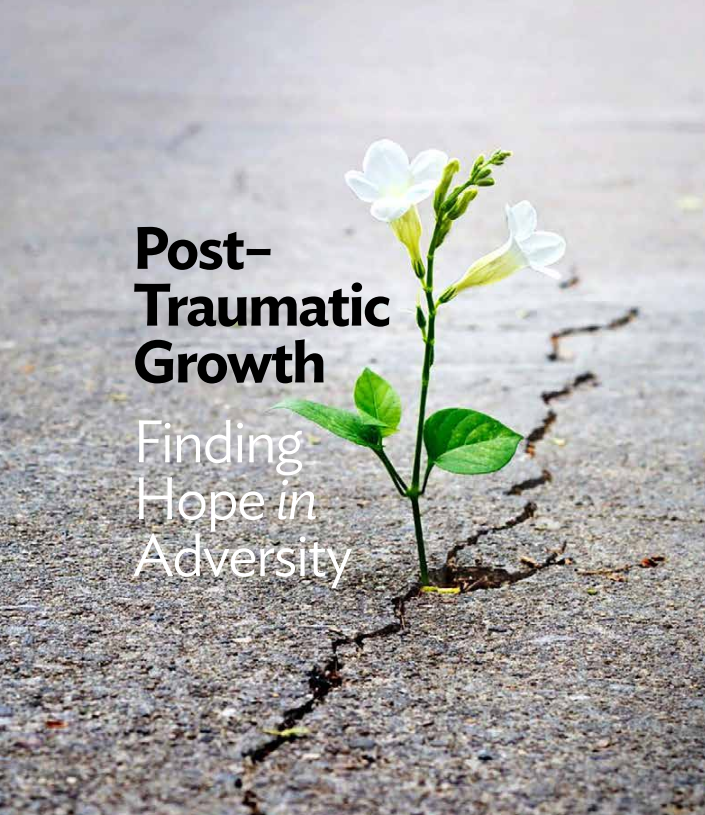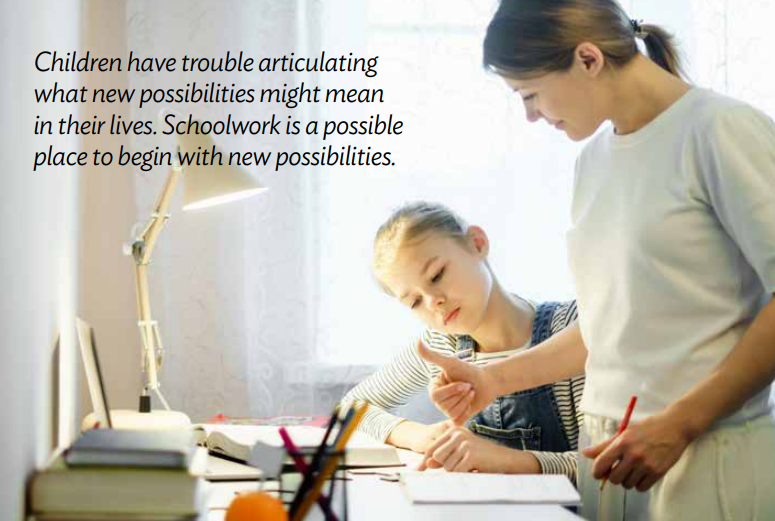
*This is an article from the Spring 2024 issue of Contentment Magazine.
By Nancy Jernigan, PhD, LPF, LPC
Post-Traumatic Growth (PTG) is based on evidence revealing progressive healing comes through adversity and gives hope and renewed strength in a greater measure than before the trauma.1 The process of post-traumatic growth is a psychological change an individual experiences as they wrestle with traumatic or highly stressful life circumstances. The process is necessary as an individual deals with trauma and struggles to find the strength to grow, change, develop, and thrive in new ways so their life can be even more productive and meaningful in the future. The struggle to thrive and grow is an important element of the process and usually involves added people in one’s life to encourage this growth. The term was coined by Lawrence Calhoun and Richard Tedeschi, two psychologists at the University of North Carolina at Charlotte, in 1995.2 The event’s severity only seems to catapult Post-Traumatic Growth. Everyone is looking for hope. We all need hope and the ability to look to the future for good things to come. PTG is full of hope and a critical benefit of mental health and wellness findings.
Mental wellness can be both preventive and responsive. PTG only responds to major crises, traumatic events, or highly challenging life circumstances. Experiencing a traumatic event can have a transformational role in someone’s life and facilitate growth. What is clear is that conscience work to grow is needed to obtain an outward benefit after the traumatic event or multiple events they wish they did not have to endure. Significant growth usually begins one to two years after the trauma, depending on the event. Most of the intense emotional processing from the tragedy is over as new change and growth develops. Trauma, mass violence, disasters, and pandemics all bring about the need for recovery. These types of traumatic events trigger a greater need for mental health attention, therapy, and growth strategies. An individual’s mindset is paramount to their growth.
PTG focuses on five key domains: personal strength, new possibilities, stronger relationships, appreciation of life, and spiritual change and growth. PTG will significantly increase an adult or child’s ability to grow, build greater resilience, and become even stronger than before the event. PTG has the greatest effect when an individual is convinced their life has many possible positive future outcomes. Resilience is integrated into the concept of post-traumatic growth and forms before the event. Resilience is a part of an individual’s makeup and an element that can be learned and developed. Components of resilience already exist in a person’s personal development, yet the theory of PTG is meant to be a focus following a traumatic event. The five domains of PTG are:
- Personal Strength – Personal strength is innate, inborn, and developed throughout one’s lifetime. When individuals decide to increase and build upon their strengths, they can do so with a specific program or emphasis in life. Growth can happen in many ways, including a self-care program. Personal strength can also be developed through a stronger identity, focus, and resilience in all aspects of life. Personal strength involves developing a self-care program in physical, social, mental, spiritual, and emotional health.
- New Possibilities in Life – New possibilities include having a positive and growth-oriented vision for the future. It means having a picture of good things to come that currently does not exist. Whether in work, relationships, or personal life, new growth is experienced through change and conceptualization.
- Relationship with Others – Relationships are key to having a strong mental health and wellness perspective. We need others to share life and engage in conversation and meaningful activities. Friendships and working relationships help us grow and learn new skills, activities, and concepts. The gift of processing or talking through what has happened in our lives is critical to better health, and in a therapeutic setting, it is called cognitive processing.3 We need strong attachments in life to be healthy and vibrant. Attachments give purpose, meaning, and stability to one’s life. They are a grounding emotional force for good, growth, and decision-making.
- Appreciation of Life – To appreciate life requires a certain mindset. A mindset that sees the good around us brings greater health and growth. These appreciations can be physical, mental, spiritual, and emotional. They can involve good exercise, nutrition, sleep, meaningful relationships, and work. Along with these disciplines comes a positive mindset that develops resilience and growth.
- Spiritual Change – Strong spiritual elements in an individual’s life will accelerate the progress of PTG. Biblical readings, prayer, and worship all increase PTG momentum. A spiritual focus and thought process increases internal, emotional, and physical strength.
The idea behind finding hope in post-traumatic growth is an important basic concept. Often, we need someone to point out our need to focus on hope versus the hard things that have occurred. This can be a peer, counselor, friend, or family member who comes alongside us to remind us to focus on hope for the future. When an individual focuses on all five domains after a traumatic event, this work brings new hope and growth.
Immediately following a traumatic event, those walking alongside an individual should begin drawing attention to becoming stronger and better than before the event. Trained counselors, psychologists, mental wellness advocates, and personal relationships should all start focusing on the idea of hope, resilience, growth, and strength as a beneficial outcome of the trauma. At first, this may seem incomprehensible, yet repeating this concept will often help the individual begin the process of mentally seeing new possibilities and hope in the future.
PTG rests on the theory that healing comes through adversity and gives hope and renewed strength. As mentioned, this strength can often be greater than before the event. PTG is most prevalent in people who actively approach challenges versus those who avoid them. If someone approaches challenges in life with a positive mindset of addressing the issues, they will have greater growth results than someone who tends to avoid challenges. Being open to change is key. As mental health advocates consistently focus on being open to change, new possibilities and hope for the future become clear, and tough situations loosen their grip on an individual’s thought process. Looking for the good in all circumstances strongly benefits the healing process. The outcome of PTG affects personal life, thoughts, environmental factors, and neurodevelopment. Neurodevelopment refers to our brain’s development and changes influencing performance and daily functions, including reading, social skills, memory, attention span, or focused skills.4 Giving someone encouragement accelerates neurodevelopment after trauma. This is also crucial for children, yet they will most likely need a parent, counselor, or mental wellness advocate to help them focus on these skills. Significant growth usually begins one to two years after the event.
 Children and adults experience PTG, yet the five domains, processing therapy, and speed of growth will vary. PTG is most prevalent in children who have adults supporting them. Children can focus on a mental health program, relationships, personal strength, appreciation for life, and spiritual change. The one domain of new possibilities in research showed children have a harder time knowing how to articulate or understand this domain like adults.5 When they think of new possibilities, it usually is in the context of one of the other domains, such as relationships (friends and family) or personal strength. Children have trouble articulating what new possibilities might mean in their lives. Schoolwork is a possible place to begin with new possibilities. A positive mindset is important to a child’s growth as further development of possibilities is processed and imagined. As their mind develops, they grasp what this means for their life. For example, they grasp in a new way doing better in school or making new friends after recovering, which is part of understanding new possibilities.6
Children and adults experience PTG, yet the five domains, processing therapy, and speed of growth will vary. PTG is most prevalent in children who have adults supporting them. Children can focus on a mental health program, relationships, personal strength, appreciation for life, and spiritual change. The one domain of new possibilities in research showed children have a harder time knowing how to articulate or understand this domain like adults.5 When they think of new possibilities, it usually is in the context of one of the other domains, such as relationships (friends and family) or personal strength. Children have trouble articulating what new possibilities might mean in their lives. Schoolwork is a possible place to begin with new possibilities. A positive mindset is important to a child’s growth as further development of possibilities is processed and imagined. As their mind develops, they grasp what this means for their life. For example, they grasp in a new way doing better in school or making new friends after recovering, which is part of understanding new possibilities.6
Children ages eight to twelve exposed to adverse events who have a high level of stress also can experience more growth in all five domains.7 Children who have a religious element in their lives experience more growth than non-religious children. The relationship and spiritual domains of post-traumatic growth seem to be the most obvious in children. PTG facilitates “new awareness” in children as they gain understanding and strengthen their ability to thrive, increase resilience, and handle daily stressors.
Children and adults can develop a five-step self-care program that accelerates strength and PTG. The goal of self-care is to develop strength and resilience and reduce the effects of anxiety and stress on our minds and bodies. Living a fulfilling life with purpose and loving relationships reduces stress.8 The Oxford Dictionary defines self-care as the practice of taking action to preserve or improve one’s health and an active role in protecting one’s well-being and happiness, particularly during stress.
In summary, finding strength and hope in adversity is at the heart of post-traumatic growth. Adverse situations may continue to affect one’s everyday life after the trauma, but having a plan and strategy to thrive and flourish amidst challenging situations will produce great gains. Developing emotional, physical, and spiritual patterns to deal with everyday stress moving forward allows for continued post-traumatic growth at new levels. The struggle needed to thrive after trauma may be strenuous, yet this arduous process is exactly what is needed. It may or may not come naturally depending on one’s temperament and skills, thus the need for a support system to be a catalyst in accelerating the process. A support system may consist of a counselor, psychologist, mental wellness advocate, a well-intentioned friend, or a family member who understands all five domains of PTG and can encourage and inspire growth. Finding hope in adversity will lead to transformational life outcomes.
References
- Calhoun, L., Tedeschi, R, Handbook on Post-Traumatic Growth: University of North Carolina at Charlotte – Psychology Press; Taylor & Francis Group; NY & London. March 28, 2006.
- Psychology Today, Post-Traumatic Growth, edited by Psychology Today. https://www.psychologytoday.com/us/basics/post-traumatic-growth. 2023.
- Calhoun, L, Tedeschi, R., Handbook on Post-Traumatic Growth: University of North Carolina at Charlotte – Psychology Press; Taylor & Francis Group; NY & London. March 28, 2006.
- BCPN.org; Brighton Center for Pediatric Neurodevelopment. BCPN.org/what-is-neurodevelopment-.html. 2023.
- BCPN.org; Brighton Center for Pediatric Neurodevelopment. BCPN.org/what-is-neurodevelopment-.html. 2023.
- National Library of Medicine, Dell’Osso, Liliana, et al. Post Traumatic Growth (PTG) in the Frame of Traumatic Experiences https://www.ncbi.nlm.nih.gov/pmc/articles/PMC9807114/#:~:text=.%2C%202022).,Tedeschi%20et%20al.,et%20al.%2C%202022, 2002.
- National Library of Medicine, Laceulle, O, Kleber, R, et al: Children’s Experience of Posttraumatic Growth: Distinguishing General from Domain-Specific Correlates, https://www.ncbi.nlm.nih.gov/pmc/articles/PMC4694619/, 2015.
- Jernigan, N., Five Step Self-Care Program: Basic Mental Wellness and Counseling, Mission of Hope International, Sep 2023.




